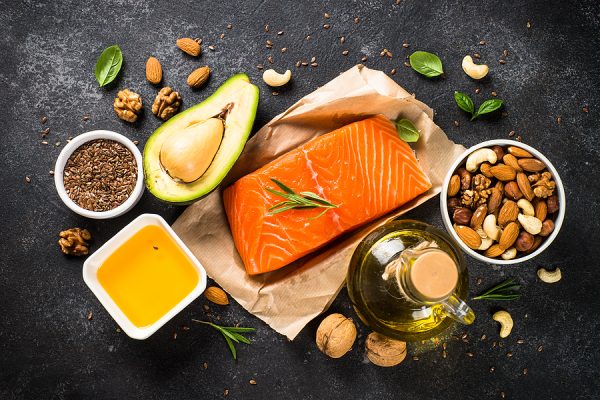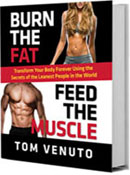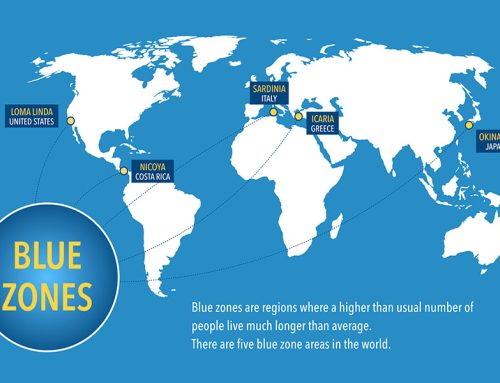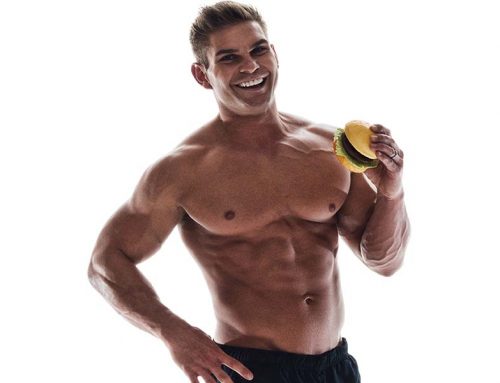Should you eat more fat? If you asked a follower of the paleo (or “ancestral”) diet, I bet their answer would probably be “yes”. If you asked a keto diet advocate, I bet the answer would be be an emphatic “YES!”But are they right or wrong? Should you eat more fat or not? This post will not only answer that question, you’ll also learn how dietary fat fits into the macronutrient tracking and meal planning system used in bodybuilding and fitness diets, which is the kind of diet I specialize in and follow myself. These are diets designed to build muscle and burn fat…

This post was prompted when a Burn the Fat, Feed the Muscle reader recently asked me:
“Hey Tom, I read in your Burn The Fat book about your 3-part ez meal creation template which is protein plus starchy carb plus fibrous carb or fruit. That’s simple and it makes sense. My question is, where do healthy fats fit in? I thought it was important to eat healthy fats?”
I think the fascination with dietary fat and the reason so many are still asking, “should you eat more fat” reveals an interesting shift in nutrition trends over the decades.
When I started in the industry in the late 1980’s and early 1990’s, that was the era of fat phobia. Back then the message was, “eat fat, get fat.” For years, most people couldn’t shake the stigma that the fat you eat turns into the fat you wear.
Then we started hearing different messages like, “There are good fats and bad fats.” Anyone remember Udo Erasmus (Fats That Kill, Fats That Heal?)
Eventually, the pendulum flipped in some parts of the diet world, and you started seeing diets claiming, “Eat more fat to lose more fat.”
I find this fascinating, but not surprising. Why? Because that’s how diet trends go. They are always changing and after a certain number of years, many of them flip flop ompletely. What was once bad for us is now good for us. At least the diet gurus say so.
That’s why, “Where do fats fit into the program” is a timely question. It’s on a lot of people’s minds, and rightfully so. There’s no doubt that dietary fat is important for health and body composition.
It’s true that you don’t see fat as one of the main 3-parts in our meal builder formula, even though dietary fats are a part of our overall daily plan. I’ll explain why below, but first, let me briefly recap the formula.
The Easy 1-2-3 meal creation formula:
There are 3 parts to a fat-burning or muscle-building meal in the Burn the Fat, Feed the Muscle system (aka, the body-building nutrition tradition)…
1. Lean Protein
2. Fibrous carb (vegetable) or fruit
3. Starchy carb (or whole grain)
Putting a meal together is that simple.
Even better, when you use this meal template, your macronutrients almost automatically fall right into the optimal range. (But you should still crunch the numbers on a spreadsheet or app if you want to fine tune your plan – I’ll show you an example below).
All you need to know is: what are the lean proteins, what are the fibrous carbs and what are the starchy carbs – those are the three primary food groups in the formula.
Here’s an example of two Burn the Fat, Feed the Muscle Meals with the individual foods plugged in:
Lunch or dinner Easy 1-2-3 meal examples:
1. Lean beef / steak (protein)
2. Broccoli (fibrous carb)
3. Brown rice (starchy carb)
1. Salmon (protein)
2. Spinach (fibrous carb)
3. Sweet Potato (starchy carb)
And here’s one more, this time with traditional breakfast foods:
1. Scrambled eggs (protein)
2. Banana (fruit)
3. Oatmeal (starchy carb)
Where does dietary fat fit in?
Our meal builder formula is a protein plus a starchy carb plus a fibrous carb. You don’t see fats mentioned in the formula, and here’s why:
There are fats inherent in the protein foods, sometimes a significant amount depending on the type. For example, just one extra large whole egg has 5 grams of fat. Six ounces of Alaskan sockeye salmon has 14.5 grams of fat – the healthiest kind of fats – omega 3.
If you eat protein foods that also contain fat, then your fat is already included in our 3-part meal formula. Even many carbohydrate foods contain small amounts of fat. For example, a cup of oatmeal has 6 grams of fat.
So, by following the 1-2-3 meal builder template above, usually dietary fat is already at least 15% if not 20% of total calories. It may be even higher unless you eat only lean proteins (like egg whites, white fish, skinless chicken breast and so on).
This is why we don’t need to suggest you “add fat to every meal” (it’s not a 1-2-3-4 meal builder formula) – the fat is usually already in there.
I do know some nutrition experts who recommend having a healthy fat at every meal. Some dietitians and nutrition organizations have a plating system where they suggest eating a palm-sized serving of protein, carbs (starchy carbs) and vegetables (fibrous carb), and a thumb-sized portion of fat with every meal.
That’s a good system too. But if you intentionally add in fats to every meal, keep in mind that a little goes a long way. “Thumb-sized portion” is pretty small. If you eat a large portion of additional fat with every meal, you’re going to have to to reduce your carbs, or else those extra fats are likely to push you over your calorie limit. High fat and high carbs together often lead to excess calories.
Case in point is keto. Keto is a high fat, very low carb diet. And contrary to popular belief, it is not a high protein diet, it’s only a moderate protein diet. Most of the calories on keto come from fat. Therefore, by definition, the other macros must be low or moderate at most.
To manage your fat intake on a balanced macro diet, you could simply look at your macro totals for the day and see if your percentage of fat calories (or grams) is lower than you wanted it. If so, then you add in an additional serving or two of healthy fat to one or more of your meals. Just drop it in somewhere during the day wherever it makes sense, to bring you to your desired level of dietary fat for the day (making sure that you stay inside your calorie limits).
For example, you might use a salad dressing that contains olive oil. You might add nuts as snacks or into a breakfast that is low in fat (or sprinkle flaxseeds on your cereal). You could put a dab of almond or peanut butter on an apple or piece of whole grain bread. You could put avocado in your salads, and so on.
Some people, especially those who don’t eat fatty fish, simply choose to take fish oil supplements, and then they’ve got the healthy fats well covered. (Though I’d argue that whole food is better than supplements any day).
In the fitness and bodybuilding nutrition tradition, most people with fat loss goals aim for about 20% of calories from fat, and some prefer to go 25% or 30% of total calories (with a slightly less carbs). This jives very well with what mainstream nutrition science says about optimal fat intakes. (The AMDR is 20% to 35%) I know some people eat more, and say they thrive on it, but generally we consider higher intakes (like keto) to be novel approaches, not the standard guideline you can count on as a sensible starting point.
With that said, dietary fat intakes don’t not need to be micromanaged or pinned down to one specific number, because there’s no single ideal intake for everyone. Fat intake targets should be kept fairly flexible and customized for each individual’s goals and preferences. If you want to go a little higher in fat, do it. If you want to go a little lower in fat, do it.
I’ve seen people successful in fat loss and bodybuilding diets with fat intakes ranging from 15% to 35% of total daily calories, so it’s definitely worth experimenting. Back in the late 80s and early 90s, I remember when a lot of bodybuilders were aiming for only 10% fat. This this was arguably not ideal because they might risk essential fat deficiency.
But I can also tell you there were some pretty lean and built guys doing it, apparently successfully, so a very low fat intake certainly didn’t make or break them. Also, many physique athletes have no choice but to drop into a steep calorie deficit to reach stage or photoshoot condition. When there’s a small calorie budget, you only have so much room for fat (or carbs), so one or both must be kept on the low side.
A sample meal plan based on macros
The best way for me to illustrate all of this is by showing you a sample meal plan. This shows all the macronutrients added up for each meal and for the day. (Just like we do it with our Burn the Fat Meal Planner Software at Burn the Fat Inner Circle).
Let’s assume our dieter is a female, 145 pounds with 25% body fat, she’s moderately active and her goal is to get leaner.
Before we do macros, the first thing we do is run her calories. Her basal metabolic rate (BMR) comes out to 1438 calories and with moderate activity level, her total calorie expenditure for the day (maintenance level) is 2229 calories. By the way, that’s pretty typical for a female with average body size and activity.
To burn fat, she needs a calorie deficit, which means she must eat fewer calories than she burns each day. Usually we choose a deficit from 15 to 30%, depending on the desired rate of fat loss. Let’s suppose she is okay being on the conservative side and “slow and steady” fat loss is her goal, so she chooses a 20% deficit. That puts her ideal calorie intake for fat loss at 1672 a day.
Meal One
1. 2 whole eggs and 2 egg whites (protein)
2. Spinach and mushrooms, 1 cup each (fibrous carb)
3. Light whole wheat toast, 2 slices (starchy carb)
349 calories, 35.3 g pro, 22.5g carb, 13.3g fat
Meal Two (snack)
1. Greek yogurt (protein/ dairy)
2. Banana (fruit)
3. Starchy carb: none, because this is a “snack” not a full meal
222 calories, 14.3g pro, 42.5g carb, .7g fat
Meal Three
1. Chicken breast, 4 oz (protein)
2. white potato baked 6 oz (starchy carb)
3. Green salad with cucumber, tomato, olive oil and balsamic dressing (fibrous carb)
388 calories, 30.9g pro, 38.1g carb, 12.6g fat
Meal Four
1. Salmon 4 oz, (protein)
2. Asparagus (fibrous carb)
3. Sweet Potato (starchy carb)
330 calories, 28.3g pro, 31.7g carb, 9.9g fat
Meal Five
1. Lean steak top round, 4 oz (protein)
2. Broccoli (fibrous carb)
3. Brown rice (starchy carb)
352 calories, 31.5g pro, 40.1g carb, 6.9g fat
Totals:
Calories: 1641
Protein: 140g (34%)
Carbs: 174g (43%)
Fat: 43.3g (23%)
Even though fat is not listed in the 3-part meal-builder formula, there’s plenty of fat in this meal plan, and take a look at where the fat came from:
Eggs are considered a protein food, but since two whole eggs were included in the breakfast scramble, that also provide a fat source. Steak is counted as a protein, but also adds several grams of fat. Chicken breast is very lean, but that provides a few grams as well. Salmon is considered a protein, but it’s also high in healthy omega-3 fats. The only place that fat was actually added that was not inherent in the food already was the olive-oil based salad dressing.
As you can see, it’s not difficult to reach 20% to 25% of your daily calories from fat just by eating typical body building and fitness diet foods. You don’t have to add even more fat at every meal to do it. In fact, you have to be a little careful with dietary fats if your goal is fat loss and you have a limited calorie budget…
Dangers of too much fat (and a warning about fad high fat diets)
For years, there have been sub-cultures in the fitness and weight loss field that promoted a mantra of, “you must eat fat to lose fat.” This is especially true in low carb communities because low carb diets are typically higher in fat (some, such as ketogenic low carb diets, are very high in fat).
It’s beyond the scope of this article to get into detail about low carb diets and how higher fat intakes fit into that picture, but I at least want to acknowledge that low carb diets are being recognized more and more as a legitimate, even if novel, weight loss option for many people.
If you wish, you can certainly experiment with higher fat intakes with fewer carbs (provided you hit your important protein and calorie goals). I simply come from the bodybuilding nutrition field, where the macros are more balanced, so that is the style and philosophy I teach.
In addition, the message “Fat is healthy” is promoted by various “natural health” or “alternative health” groups. Yes, it is true that you need to eat essential fats for a variety of health reasons.
Unfortunately, the messages from many of these communities to “eat more fat” or “eat healthy fat” often get taken too far. Unsuspecting dieters who don’t know how to create macro-based meal plans, often add in so much extra fat, they go over their calorie limit and weight loss stalls. (Those so called “health” crazes with people chugging coconut oil or putting butter in their coffee was crazy).
Ironically, many are left scratching their heads wondering why they’re not losing. Of course, the answer is simple: Dietary fats have a high calorie density (9 calories per gram) and just because a food is healthy doesn’t mean you can or should eat it in large (let alone unlimited) quantities. You must fit all your macros inside a certain calorie budget.
There are so many marketing claims being made about fat these days – entire books are written about “miracle fats” or “fat burning fats” and so on. But many of the claims are false or misleading. There is nothing magical about the fat in grass-fed beef, or Himalayan Yak butter or coconut oil or any other fat that leads to greater fat loss. Even fats that have a small thermogenic quality like Medium-Chain Triglycerides require that you replace fats, not stack additional fat on top of your current intake.
Here’s the bottom line: Eating fat doesn’t make you fat. A calorie surplus makes you fat. Eating fat doesn’t make you lose fat. A calorie deficit makes you lose fat. You’ve got to achieve that calorie deficit if you want to lose fat. You also need to leave room for protein, which is essential, and for carbs, which while not technically essential, are certainly essential on a practical level for the hard training athlete or lifter.
The advice you may have heard, “You don’t need to fear dietary fats” is correct. The suggestion to include fats in your meals every day is correct. But as you’ve learned from reading this, it’s not difficult to get enough fat just from eating regular, healthy body-building foods.
That’s what Burn the Fat, Feed the Muscle is all about: Eating mostly unprocessed, whole foods with just the right balance between protein, carbs and fat. It’s not a diet, it’s a by-the-numbers and structured, yet flexible way of eating, designed to build you a great body. Build muscle, build strength, build fitness, build health and burn fat too!
Train hard and expect success,
– Tom Venuto,
author of Burn The Fat, Feed the Muscle (BFFM)
author of BFFM Guide to Flexible Meal Planning For Fat Loss
Founder/CEO Burn The Fat Inner Circle
Get The Classic Burn the Fat, Feed The Muscle Book:
www.amazon.com/Burn-Fat-Feed-Muscle-Transform
Already Have The Book? Awesome! The Next 2 Steps Are:
1. Join The Community (Before prices go up):
www.BurnTheFatInnerCircle.com
2. Get the newest book in the Burn the Fat Feed the Muscle series:
The Guide To Flexible Meal Planning For Fat Loss

Tom Venuto is a natural bodybuilding and fat loss expert. He is also a recipe creator specializing in fat-burning, muscle-building cooking. Tom is a former competitive bodybuilder and today works as a full-time fitness coach, writer, blogger, and author. In his spare time, he is an avid outdoor enthusiast and backpacker. His book, Burn The Fat, Feed The Muscle is an international bestseller, first as an ebook and now as a hardcover and audiobook. The Body Fat Solution, Tom’s book about emotional eating and long-term weight maintenance, was an Oprah Magazine and Men’s Fitness Magazine pick. Tom is also the founder of Burn The Fat Inner Circle – a fitness support community with over 52,000 members worldwide since 2006. Click here for membership details








Thank you for this helpful article. It was a topic I wondered about for a while!
This misses on so many points. 1. Fats add to satiety. particularly with people who have prediabetic conditions. Once you achieve a ketosis based energy system vs a glucose based energy system, you can easily fast for days, to achieve additional benefits of autophagy.
2. eating a little bit of starchy carb, for some metabolic types, is like eating a little bit of ice cream. It is not, as simple as caories in, vs calories out. Humans are emotional, and hormones dictate cravings. If you are of a specific metabolic type, and consume even a few grams of starchy carbs, or God forbid, processed carbs, you set yourself up for a harder homonal/emotional row to hoe, between meal times. While a fat heavy diet, and the added satiety, more level hormone secretions, and more energetic brain, all combine to making it easy to skip a meal, if you went a little too heavy on the fat the past day or so.
This is not even touching on the subject of excess fats passing thru the body, if the glycemic index stays below a certain level.
I dont care about team starchy carbs and 5 meal a day plans, vs keto or carnivore. all I care about is what truly works, and how much we are lied to by health and food industry grifters. from meat makers that inject corn syrup into their processed meats, to boxed food makers that actually engineer their foods to be addictive, and never provide base satiety. To sugar water manufacturers that pay academics and thought leaders to declare anyone who opposes them as racist, so that they can get their products on the US food stamp program SNAP (true story).
I eat all the fat i can stomach, I will literally eat it until i mildly feal nauseous, and then that is all i eat for 24 hours, and sometimes 48 or 72 hours. I lose 2 to 4 pounds a week. and if I get cravings I eat nutritional super foods like eggs, sardines, or organ meats, and lots more fat, until i am back in the easy zone. rinse and repeat.
eczema like skin condition, where my work boots rub my calf, gone. neuropathy, and swelling ankles, gone. late evening cravings for junk/fast food, gone. zombie brain fog, gone
Hi “fat eater” … ‘great’ screen name. Thank you for giving me an idea for a future blog post about how humans attach their identity to their diet…. like Pete paleo, or Keto Karen, or Vegan Valerie… or… Fat eater”.. great.. thats the person you are … fat eater …
My post misses ZERO points in the context in which they were framed… I know that context is everything, including when it comes to what diet (and macros) is best for each individual…
people who lift weights many times a week and are reasonably lean and are highly active and are not obese, and are not sedentary have ZERO of the issues of which you speak, except in rare cases of genetics …
And thats the audience of this blog. People who lift and train.
If you say, “I dont care about ‘team starchy carbs and 5 meals a day’ then why are you even here? Are you just trolling?”
If not, Im guessing you know little about me. If you want to learn what I think about high fat low carb diets, youre welcome to read and respond to this post: https://www.burnthefatinnercircle.com/public/ketogenic-keto-low-carb-high-fat-diets-FAQ.cfm
You think I dont know what keto is or high fat diets are? I have done keto or high fat/ low carb diets multiple times. First time was in the 1980s. were you even born then? Vince Gironda was my first bodybuilding coach. My first “fat loss” diet was steak and eggs
I know how high fat low carb diets work and I know that they do work, but I also know based on the current science that they work no better diet than any other diet. And they are NOT optimal for muscle building diets.
and for as many people as a high fat low carb diet works for, there are a lot more who say they are unsustainable .
Im not an an obese sedentary person with metabolic syndrome, Im lean and I train many hours a week and I can handle a large percentage of my calories from starchy carbs (like oats, potatoes, rice, legumes and so on). I use the diet that works for people like me. If you lift weights and live like an athlete then you can eat like an athlete.
at the end of the day Its all about finding the right diet for you… not being a zealot and proclaiming your way is better than everyone elses.
i actually paid for your book, and your program and you little community, and failed miserably in my goals, because your program is geared toward people who do body building as a profession. you gamma attack on my name is pathetic, way beneath what I expected, and shockingly defensive, to be honest. But yea, this is the first time i have responded to your grifting emails, in years, because that is just what they are, grifting emails, but with my recent success, with avoiding your suggestions, I thought I would see what lies you were selling your people, and i was not surprised, The Tom Venuto of old used to quote studies to support his claims, you just make claims now with no studies to back up your bull shit. if that is trolling, I hate to even describe what you are doing, I suggest your readers subscribe to actual MD’s like Dr. Berg, or Dr. Fung, or Dr. Berry. because body build tom venuto is full of shit. of course he is too weak to post this response.
that you follow people like fung is all people who follow this blog need to hear. Congrats if you’ve had success with the low carb high fat approach, but you don’t quite have it yet. It may be more helpful to look up people like Alan Aragon and James Krieger and Kevin hall and their writings on LCHF, Insulin, etc, if you want to grasp it on a better level, as well as the primary research that is peer reviewed (not “low carb doctors”… )
btw, bodybuilders of old, used to recommend steak and eggs to build muscle mass… that was before there was money to be made doing what you are doing. But you knew that already.